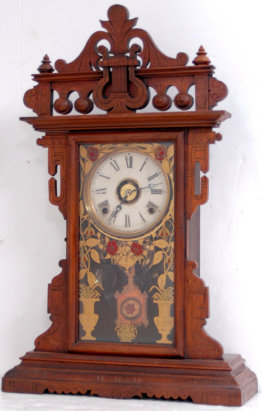
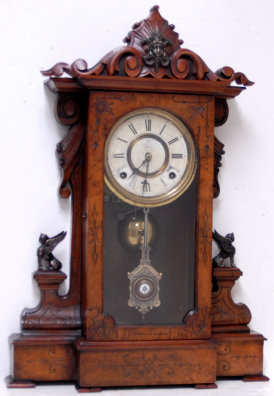
77. $1750
Atkins Clock Co. “Parlor No. 1” case, with a 30-day wagon spring movement, ca 1852. The rosewood case is 17.5” high, 13” wide, and 5” deep. The case style was very unusual for its day with a very detailed beveled front, top and base. The two doors have knobs but not ivory (bone) knobs that were used often. They look original to me. The bottom door has a replacement painted glass. The top glass has original gold leaf with over painting. The painted metal dial has no flaking but I suspect it was repainted at some time. It has old hands and an old brass pendulum bob. The wagon spring frame is cast iron and has a decorative scroll design. The plates are brass, spokes with no bushings. Typically this model had no label and this one is no exception. I have sold at least 2, probably a few more, of this exact model, and in each case I called the clock a Welch, Whiting & Co.” production. In the book, “The Clocks of Irenus Atkins”, by Philip C. Gregory & Robert M. King, this case is shown with different movements but never with a wagon spring movement. Credit is given to Atkins alone for the wagon spring clocks. This clock is complete and original except where noted, and is in running condition. $1750-$2500.

78. $450
Ansonia Clock Company, handing clock, the “Capitol”, ca 1901.
Ansonia made this clock many ways, with several different looks, movements, etc. Our clock has a double weight driven time only movement,
with seconds dial. The 8-day movement is nickel plated and signed by Ansonia. The old dial is original, the three hands are correct,
it has brass dial rings, brass bob and wood stick, the beat scale, and Lady Minerva on the top, all look correct. The 54” cherry case,
YES CHERRY, is clean and polished; there are three good glasses, and a door latch on the side. The consignor thinks the bottom side
finials may be replacements of the early style design. This is a lot of clock for this minimum. Depending on condition and accessories,
we have seen these sell from $1500-$2000. Ly-Ansonia, page 184. $500-$750.
76. $975
“US Clock Co. New York”, copied from the dial and the brass movement of this very rare parlor clock, ca 1872. They made fine floor and wall regulators, and various styles of shelf clocks. It is not known where the clocks were made. You will have to admit that the style of the case is a few notches above the normal parlor clocks of that period. Note the cast pewter objects on the sides and the top, the outstanding carvings top and sides, etched designs all over the case and the 4 metal feet underneath. The glass is original, so is the signed dial, brass dial rings, nickel bell and the pendulum that looks like those in Welch clocks. That might make one think that the clock was made by Welch as Welch made more unusual cases like this one than any other maker. The rosewood case is 24 inches tall. $1000-$1500.
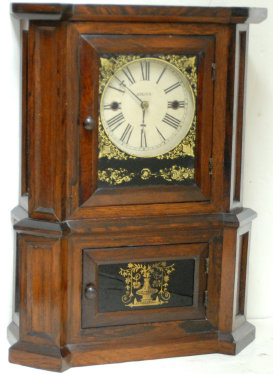
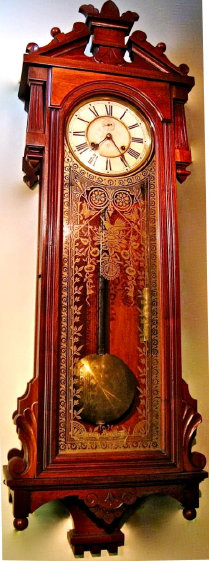
79. $1300
Ansonia Clock Co. hanging, “Prompt”, ca 1901. One hundred percent
original walnut or mahogany case, 50” high, has the original finish and no repairs or new wood. As you can see the large glass is
fantastic and has only slight wear. Note the original humming bird glass with the flowers and butterflies. There are glasses on the
sides. All the clock parts are unquestionably original including the 8-day weight driven movement, good eight-inch dial, hands, brass
pendulum bob, wood stick, and a signed beat scale. The movement is signed and is running very strong. If you want an original and
hard to find Prompt model, this one is certainly all original and you should give it consideration as it is as nice as we have ever
seen. Ly-Ansonia #599. $2500-$3000.
75. $350
“E. N. Welch Mfg. Co., Forestville, Conn.”, mantel clock, “Gilmore”,
ca 1885. This is another very rare model, not that it is all that unusual, but one has never come my way and I cannot find where one
has sold anywhere. The walnut case is 25 inches, has a complete label on the back, a real nice and original painted door glass, fancy
Welch pendulum, original dial, Cathedral gong, alarm movement with brass bell, and the typical Welch 8-day time and strike movement
that is running and striking. The case has some very unusual designed cutouts and attachments on the top and grooved designs top to
bottom. Ly-Welch #428. $350-$500.


80. $2400
Ansonia Clock Co. wall clock, “Medina”, ca 1886. Perhaps the
most rare and hard to find clock of any in this auction. In 45 years this is only the second one I have offered for sale. The
near mint mahogany case is 52 inches tall, original finish with no more done to it than occasionally polished. There is no damage
or replaced parts. All finials and attached parts are original and the carvings are unusual and were expertly done. The 8-day double
spring movement is running and striking hours on a gong. It has an 8-inch porcelain dial that is also perfect. Other than our sale
some 30 years ago I cannot find another Medina that has sold anywhere. Ly-Ansonia #553. $2500-$3000.

81. $2500
French Mystery double statue clock with swinging pendulum, ca
1867. Most observers think the pendulum is a torsion, or rotates like a conical pendulum. In fact, it is neither, but is a true mystery
movement. The movement is 8-day and it is running. This clock has a ball top on which the brass dial numerals and gold hands are attached.
It stands almost 22 inches high. Holding the movement aloft are two bronzed cast white metal figures that are called “Harvest Queen”.
All are on a metal base with metal designs and attached ornaments. It has the original finish that is near perfect. Note the balls
and base have a green shade. $3000-$5000.
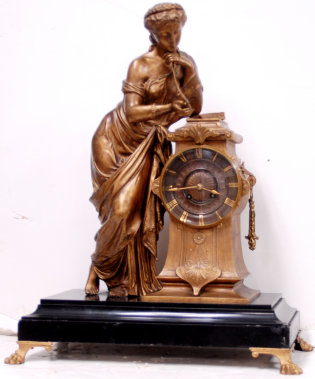
82. $850
French Empire, ormolu figural bronze mantel clock, ca 1830. It
has good gilding with minor loss. I cannot decide what she is but her official name is, “Reminisce”. She is admiring or pondering
about a jewel in her hand. Whatever she is, she is beautifully outfitted, hair is perfect, and she has all her fingers and toes. On
top of the clock there is a book. It has a perfect metal dial, tinted brown, with gold numerals and pair of French hands. The clock
is 21 inches tall and has all its original pieces and parts. The 8-day movement is typical of most French movements, round, outside
count, and bell strike. It has a correct pendulum. Nothing is signed but it is typical of French clocks from this era. They had some
screwy laws that prohibited them from using makers names and other information. The only provenance I have is that the clock came
from an aristocratic family estate in Chicago and had been in the family for generations and believed to have been brought to the
US by the emigrating family. $1000-$2000.
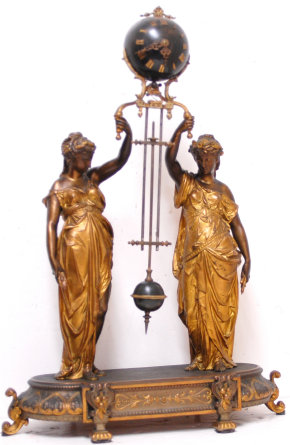
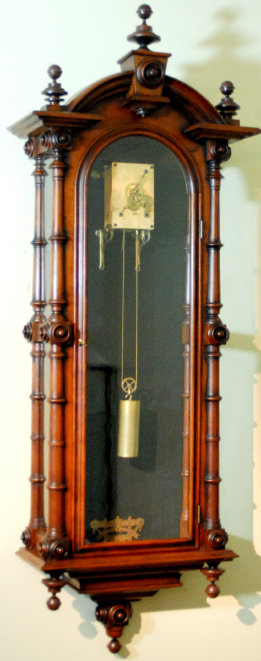
83. $2900
Welch, Spring & Co. “No. 7 Regulator”, ca 1882. This clock
is also called the hanging “Patti Regulator No. 7”. They made this model using three different movements, double spring, one weight,
and two weights. Our clock is the one weight model that is rarer than the two-weight model. The one weight model has a sweep second
hand while the two weight does not. This case is made of Black Walnut with what Welch called, “Extra Fine Finish”. It is 47 inches
high, has five finials on top and five on the base. On first glance they all look alike; however, the top finials are slightly different
than those on the bottom. All the finials look like those pictured in the catalogs. It has a large brass beat scale signed, “Welch,
Spring & Co.”, a large door glass, two glasses on each side, five glasses in all, and they appear to be original. It has a brass
weight and pulley but we do not know if they are original. The eight-day sweep second hand movement is time only, running, and original
to the case. It mounts to an iron back plate. Included is the correct size hour and minute hands, pendulum hanger bracket, and an
original Patti No. 7 Regulator winding crank. It is missing the dial and pendulum. If we had those items we would be talking
five figures for this rare clock. Ly-Welch, page 104. $3000-$4000.

84. $1200
Waltham Clock Co. signed on the movement of this ca 1930 banjo
clock. This clock uses Waltham’s famous 8-day timepiece weight driven movement. The original internal parts are the movement, pendulum,
pendulum stick, weight chute metal cover, and pendulum tie down block. The lead weight is correct, the glasses are original and have
a few minor paint chips that are hardly noticeable. The bottom glass is signed, “Willard’s Patent”. The dial is original, signature
is good, hands are original, and the two door latches are in good working order. Mahogany case has the original finish, gold leaf
over the front, stands near 42 inches high, and retains the original top finial, bowed glass over the dial, brass side rails and balls
over the base. This style Waltham banjo clock regularly sells everywhere, in the $2000-$3000 range. Ly-American Clocks, Volume 1,
#906. That is the exact model we are listing for sale. It was their most expensive model in 1930 except for the Lyre models. $1500-$2000.